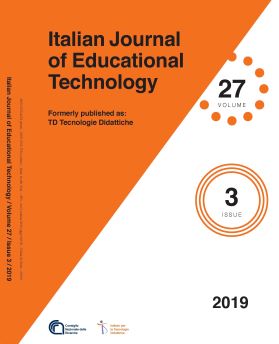LA PERCEZIONE DEGLI STUDENTI NELLA VALUTAZIONE DEI CORSI UNIVERSITARI EROGATI IN MODALITÀ BLENDED
Contenuto principale dell'articolo
Abstract
La diffusione dei corsi accademici in modalità blended fa emergere da un lato la necessità di esplicitare il significato dell’espressione “didattica mista”, andando anche oltre l’inevitabile sinteticità della definizione proposta dall’ANVUR, e dall’altro l’urgenza di elaborare un adeguato quadro di riferimento (framework) in grado di orientare il complesso processo di valutazione di questa nuova modalità della didattica universitaria. La percezione degli studenti costituisce da sempre uno degli aspetti più importanti da considerare nel momento in cui si decide di valutare la didattica. Scopo del contributo è quello di descrivere il metodo e i risultati di un’indagine condotta su un campione di studenti iscritti ai quattro Corsi di Studio dell’Università degli Studi di Modena e Reggio Emilia (UNIMORE) erogati in modalità mista (blended).
Dettagli dell'articolo
Gli autori che pubblicano su questa rivista accettano le seguenti condizioni:
- Gli autori mantengono i diritti sulla loro opera e cedono alla rivista il diritto di prima pubblicazione dell'opera, contemporaneamente licenziata sotto una Licenza Creative Commons CC BY 4.0 Attribution 4.0 International License.
- Gli autori possono aderire ad altri accordi di licenza non esclusiva per la distribuzione della versione dell'opera pubblicata (es. depositarla in un archivio istituzionale o pubblicarla in una monografia), a patto di indicare che la prima pubblicazione è avvenuta su questa rivista.
- Gli autori possono diffondere la loro opera online (es. in repository istituzionali o nel loro sito web) prima e durante il processo di submission, poiché può portare a scambi produttivi e aumentare le citazioni dell'opera pubblicata (Vedi The effect of Open Access).
Riferimenti bibliografici
Bowyer, J., & Chambers, L. (2017). Evaluating blended learning: Bringing the elements together. Research Matters: A Cambridge Assessment Publication, 23, 17-26. Retrieved from https://www.cambridgeassessment.org.uk/Images/375446-evaluating-blended-learning-bringing-the-elements-together.pdf
Calderon, O., Ginsberg, A. P., & Ciabocchi, L. (2012). Multidimensional Assessment of Pilot Blended Learning Programs: Maximizing Program Effectiveness Based on Student and Faculty Feedback. Journal of Asynchronous Learning Networks, 16(4), 23-37. Retrieved from https://eric.ed.gov/?id=EJ982679
Chandra, V., & Fisher, D. L. (2009). Students’ perceptions of a blended web-based learning environment. Learning Environments Research, 12(1), 31–44. doi: 10.1007/s10984-008-9051-6
Chang, V. (1999). Evaluating the effectiveness of online learning using a new web based learning instrument. Proceedings Western Australian Institute for Educational Research Forum 1999. Retrieved from http://www.waier.org.au/forums/1999/chang.html
Chang, V., & Fisher, D. L. (2003). The validation and application of a new learning environment instrument for online learning in higher education. In M. S. Khine & D. L. Fisher (Eds.), Technology-rich learning environments: A future perspective (pp. 1–20). Singapore, SG: World Scientific publishing Co. pte. Ltd.
Donnelly, R. (2006). Blended problem-based learning for teacher education: Lessons learnt. Learning, Media and Technology, 31(2), 93-116. doi: 10.1080/17439880600756621
Ellis, R. A., Pardo, A., & Han, F. (2016). Quality in blended learning environments - Significant differences in how students approach learning collaborations. Computers & Education, 102, 90-102. doi: 10.1016/j.compedu.2016.07.006
Garrison, D. R., & Vaughan, N.D. (2008). Blearning in higher education - Framework, principles and guidelines. San Francisco, CA, USA: Jossey-Bass.
Graham, C. R. (2004). Blended Learning Systems: Definition, current trends, and future directions. In C. J. Bonk & C. R. Graham (Eds.), Handbook of blended learning: Global perspectives, local designs (pp. 3-21). San Francisco, CA, USA: Pfeiffer.
Graham, C. R. (2013). Emerging practice and research in blended learning. In M. G. Morre (Ed.), Handbook of Distance Education (pp. 333-350). New York, NY, USA: Routledge.
Graham, C. R., Woodfield, W., & Harrison, J. B. (2012). A framework for institutional adoption and implementation of blended learning in higher education. The Internet and Higher Education, 18, 4–14. doi: 10.1016/j.iheduc.2012.09.003
MIUR (2016). Decreto Ministeriale n. 635, 8/8/2016.
MIUR (2019). Decreto Ministeriale n. 6, 7/1/2019.
Moore, J. C. (2005). The Sloan Consortium Quality Framework and the Five Pillars, Retrieved from http://www.mit.jyu.fi/OPE/kurssit/TIES462/Materiaalit/Sloan.pdf
Ozkan, S., & Koseler, R. (2009). Multi-dimensional students’ evaluation of e-learning systems in the higher education context: An empirical investigation. Computers & Education, 53(4), 1285–1296. doi: 10.1016/j.compedu.2009.06.011
Pombo, L., & Moreira, A. (2012). Evaluation framework for blended learning courses: A puzzle piece for the evaluation process. Contemporary Educational Technology, 3(3), 201-211. Retrieved from https://dergipark.org.tr/en/pub/cet/issue/25729/271463
Quagliata, A. (2008). Competenze per lo sviluppo delle risorse umane. Esperienze di formazione blended. Roma, IT: Armando Editore.
Sannicandro, K., De Santis, A., Fazlagic, B., Bellini, C., Tedeschi, C., & Minerva, T. (2018). Attivazione, erogazione e monitoraggio dei corsi di laurea blended dell’Università degli studi di Modena e Reggio Emilia. In A. Volungeviciene & A. Szűcs (Eds.), Exploring the Micro, Meso e Macro. Navigating between dimensions in the digital learning landscape. EDEN 2018 Annual Conference, Genoa, Italy 17-20 June 2018 (pp. 834-42). Budapest, HU: European Distance and E-Learning Network.
Smythe, M. (2011). Blended learning: A transformative process? Paper presented at National Tertiary Learning & Teaching Conference 2011. Nelson, New Zealand, 12-14 October 2011. Retrieved from https://akoaotearoa.ac.nz/community/national-teaching-andlearning-conference-2010/resources/files/smythe-blended-learning-transformativeprocess
Spring, K. J., & Graham, C. R. (2017). Thematic patterns in international blended learning literature, research, practices, and terminology. Online Learning, 21(4), 337- 361. Retrieved from https://www.learntechlib.org/p/183777/
UNIMORE (2016). Carta dei servizi. Corso di laurea in Scienze e Tecniche Psicologiche in modalità blended. Retrieved from http://www.des.unimore.it/site/home/didattica/scienze-e-tecniche-psicologiche.html

